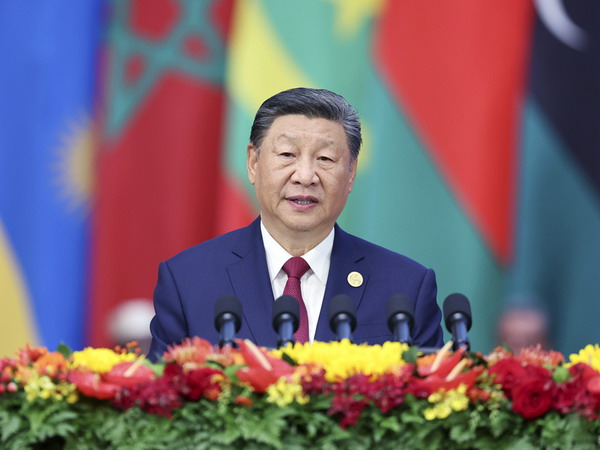On June 28, 2024, the Conference Marking the 70th Anniversary of the Five Principles of Peaceful Coexistence was held in Beijing. President Xi Jinping of the People’s Republic of China attended the conference and delivered an important address. Premier Li Qiang of the State Council of the People’s Republic of China moderated the conference. Former political leaders from countries including Viet Nam, Myanmar, Sri Lanka, Laos, Thailand, Indonesia, the Maldives, Egypt, Ethiopia, South Africa, Kyrgyzstan, Moldova, Brazil, Guyana, Japan, Republic of Korea, Italy, France, Croatia and Slovenia, representatives of international/regional organizations, and diplomatic envoys, academics, friends, as well as representatives of the press and the business community from more than 100 countries were present at the conference. The conference issued the Beijing Declaration.
Under the theme of “From the Five Principles of Peaceful Coexistence to Building a Community with a Shared Future for Mankind” and with four sub-forums focusing respectively on the Contemporary Value of Asian Wisdom, the Vision and Mission of the Global South in a Shifting Landscape, Contributing to Global Prosperity through Chinese Modernization, and Promoting Global Governance Featuring Extensive Consultation and Joint Contribution for Shared Benefits, the commemorative events broadened consensus among the parties on building a community with a shared future for mankind.
As the host of the commemorative events, the Chinese side summarized the key viewpoints of the participants as follows:
1. Seventy years ago, Chinese leaders put forth in full the following Five Principles, i.e. mutual respect for sovereignty and territorial integrity, mutual non-aggression, mutual non-interference in each other’s internal affairs, equality and mutual benefit, and peaceful coexistence. These principles were included in China’s joint statements with India and Myanmar, which called for establishing the Five Principles of Peaceful Coexistence as the basic norm in state-to-state relations. The appeal has had an epoch-making significance.
2. Over the past seventy years, the Five Principles of Peaceful Coexistence have shown everlasting relevance. Informed by Asian wisdom, they have become open, inclusive, and universally applicable basic norms for international relations and fundamental principles of international law. They have made indelible historic contributions to the cause of human progress.
3. The Five Principles of Peaceful Coexistence are consistent with the purposes and principles of the Charter of the United Nations, and reflect the underlying trend of international relations. With a greater emphasis on mutuality and equality, these principles provide a whole set of basic norms for peaceful coexistence among countries across political, security, economic and diplomatic domains, and have a far-reaching impact on the development of international relations and international law.
4. The Five Principles of Peaceful Coexistence have opened a new path for the establishment and development of relations between countries with different social systems. These principles enable countries to break free from antagonistic and confrontational mindsets, coexist peacefully on the basis of equality and mutual respect, and resolve disagreements and disputes by peaceful means.
5. The Five Principles of Peaceful Coexistence have bolstered the efforts of developing countries to deepen solidarity and cooperation and seek strength through unity. These principles have inspired developing countries to find independent paths of development, and contributed to the improvement and development of North-South relations.
6. The Five Principles of Peaceful Coexistence were designed to protect the legitimate rights and interests of developing countries, and redress the systems of imperialism, colonialism and hegemonism. These principles have laid an intellectual foundation for and lent impetus to a more just and equitable international order.
7. The Five Principles of Peaceful Coexistence are showing greater vitality amidst global transformations not seen in a century. Building a community with a shared future for mankind is a natural step for carrying forward the Five Principles of Peaceful Coexistence under the new circumstances, and enriches the Five Principles of Peaceful Coexistence with the imperatives of the new era.
8. The Vision of Building a Community with a Shared Future for Mankind carries forward the essence of the Five Principles of Peaceful Coexistence, and builds on them to better reflect the reality that all countries share the same future. The overarching goal is to build a world of lasting peace, universal security and shared prosperity and one that is open, inclusive, clean and beautiful, which points the direction for all countries to work together on Earth, the planet we call home.
9. The participants spoke positively of China’s proposals for advancing high-quality Belt and Road cooperation, the Global Development Initiative, the Global Security Initiative, and the Global Civilization Initiative, and recognized their great significance for safeguarding international peace and security, promoting global sustainable development, and contributing to human civilization and progress. These initiatives offer concrete and workable pathways toward building a community with a shared future for mankind.
10. The essence of the Five Principles of Peaceful Coexistence is sovereign equality, which is the most important norm in state-to-state relations. All countries are equal. The big should not subdue the small, the strong should not bully the weak, and the rich should not exploit the poor. World multipolarity should be characterized by equality and order. International law should be applied in an equal and uniform manner to all countries. Double standards and exceptionalism should be rejected.
11. Mutual respect is a ground rule of state-to-state interaction and the basis of building a new type of international relations. Considering that countries differ in historical and cultural traditions and development stages, it is imperative to respect the development paths and systems chosen independently by the people of other countries, not to impose one’s will on other countries, and not to interfere in their internal affairs. Major countries should set an example.
12. All countries should take the path of peaceful development, act on the vision of common, comprehensive, cooperative and sustainable security, work for building a more balanced, effective and sustainable security architecture, and resolve major international and regional issues through dialogue rather than confrontation.
13. In the era of economic globalization, it is important to promote development and achieve mutual benefit through cooperation. It is also important to make the global economy bigger and let more countries have an equitable share in the benefits of development, thus making globalization more universally beneficial and inclusive. Unilateral and protectionist measures in violation of the laws of economics and market principles will end up harming all sides.
14. Promoting the Five Principles of Peaceful Coexistence is conducive to safeguarding international fairness and justice and upholding true multilateralism. It is important to jointly defend the international system with the United Nations at the center and advance global governance characterized by extensive consultation and joint contribution for shared benefit. Hot-spot issues, such as the Ukraine crisis and the Palestinian-Israeli conflict, can only be resolved by a political settlement through dialogue and consultation. Global challenges, such as those emanating from climate change and artificial intelligence, must be addressed through open cooperation.
15. Exchanges and mutual learning between civilizations drive human progress. It is important to respect the diversity of civilizations in an open and inclusive spirit, reject the discriminatory and exclusionary notion of “civilizational superiority,” and refrain from inciting clashes of civilizations. Peace, development, equity, justice, democracy and freedom are humanity’s common values. They command the greatest global consensus and should be upheld by all.
16. The Global South is a key force that advocates and practices the Five Principles of Peaceful Coexistence. It should be the staunch force for peace, the core driving force for open development, the construction team of global governance, and the advocates for exchange among civilizations. It can make a greater contribution to South-South and North-South cooperation as well as human progress.
17. The participants commended the announcements by China for supporting Global South cooperation, which include:
- Establishing a Global South research center, providing 1,000 scholarships under the Five Principles of Peaceful Coexistence Scholarship of Excellence and 100,000 training opportunities to Global South countries in the next five years, and launching a Global South youth leaders program;
- Further leveraging the China-U.N. Peace and Development Fund, the Global Development and South-South Cooperation Fund, and the Climate Change South-South Cooperation Fund, and working with interested parties to set up a tripartite center of excellence for implementing the Global Development Initiative, so as to facilitate growth in Global South countries;
- Renewing the China-IFAD South-South and Triangular Cooperation Facility and making an additional Renminbi contribution equivalent to U.S.$10 million to be used to support agricultural development of the Global South;
- Discussing free trade arrangements with more Global South countries, continuing to support the WTO’s Aid for Trade initiative, renewing contribution to the WTO’s China Program, and welcoming more Global South countries to join the Initiative on International Trade and Economic Cooperation Framework for Digital Economy and Green Development; and
- Between now and 2030, China’s import from fellow developing countries is expected to exceed U.S.$8 trillion.
18. The participants spoke highly of the enormous achievements in Chinese modernization and China’s relentless efforts for and contribution to safeguarding world peace, promoting friendly cooperation with other countries, and advancing common development of the world.
19. The participants were grateful for China’s thoughtful organization of the commemorative events. They expressed readiness to work with China to turn into reality the wide-ranging consensus reached at the events, continue championing the Five Principles of Peaceful Coexistence, and build a community with a shared future for mankind in order to create a better future for human society. (PR)

 Local1 week ago
Local1 week ago
 International3 weeks ago
International3 weeks ago
 Business3 weeks ago
Business3 weeks ago
 Tourism2 weeks ago
Tourism2 weeks ago
 Sports1 week ago
Sports1 week ago
 Government2 weeks ago
Government2 weeks ago
 Local3 weeks ago
Local3 weeks ago
 Government4 weeks ago
Government4 weeks ago






















